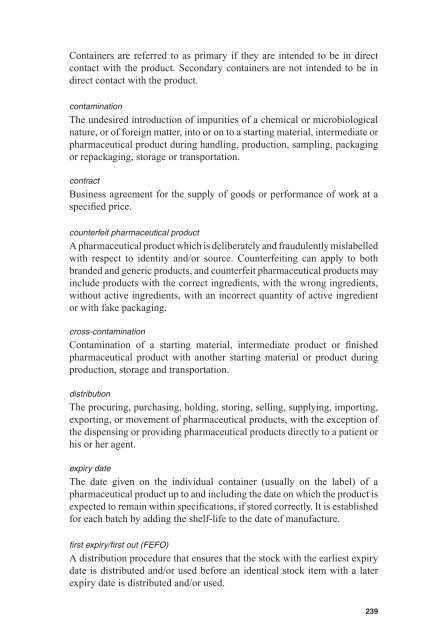Annex 5 WHO good distribution practices for pharmaceutical products
Annex 5 WHO good distribution practices for pharmaceutical products
Annex 5 WHO good distribution practices for pharmaceutical products
Create successful ePaper yourself
Turn your PDF publications into a flip-book with our unique Google optimized e-Paper software.
Containers are referred to as primary if they are intended to be in directcontact with the product. Secondary containers are not intended to be indirect contact with the product.contaminationThe undesired introduction of impurities of a chemical or microbiologicalnature, or of <strong>for</strong>eign matter, into or on to a starting material, intermediate or<strong>pharmaceutical</strong> product during handling, production, sampling, packagingor repackaging, storage or transportation.contractBusiness agreement <strong>for</strong> the supply of <strong>good</strong>s or per<strong>for</strong>mance of work at aspecified price.counterfeit <strong>pharmaceutical</strong> productA <strong>pharmaceutical</strong> product which is deliberately and fraudulently mislabelledwith respect to identity and/or source. Counterfeiting can apply to bothbranded and generic <strong>products</strong>, and counterfeit <strong>pharmaceutical</strong> <strong>products</strong> mayinclude <strong>products</strong> with the correct ingredients, with the wrong ingredients,without active ingredients, with an incorrect quantity of active ingredientor with fake packaging.cross-contaminationContamination of a starting material, intermediate product or finished<strong>pharmaceutical</strong> product with another starting material or product duringproduction, storage and transportation.<strong>distribution</strong>The procuring, purchasing, holding, storing, selling, supplying, importing,exporting, or movement of <strong>pharmaceutical</strong> <strong>products</strong>, with the exception ofthe dispensing or providing <strong>pharmaceutical</strong> <strong>products</strong> directly to a patient orhis or her agent.expiry dateThe date given on the individual container (usually on the label) of a<strong>pharmaceutical</strong> product up to and including the date on which the product isexpected to remain within specifications, if stored correctly. It is established<strong>for</strong> each batch by adding the shelf-life to the date of manufacture.fi rst expiry/fi rst out (FEFO)A <strong>distribution</strong> procedure that ensures that the stock with the earliest expirydate is distributed and/or used be<strong>for</strong>e an identical stock item with a laterexpiry date is distributed and/or used.239
















